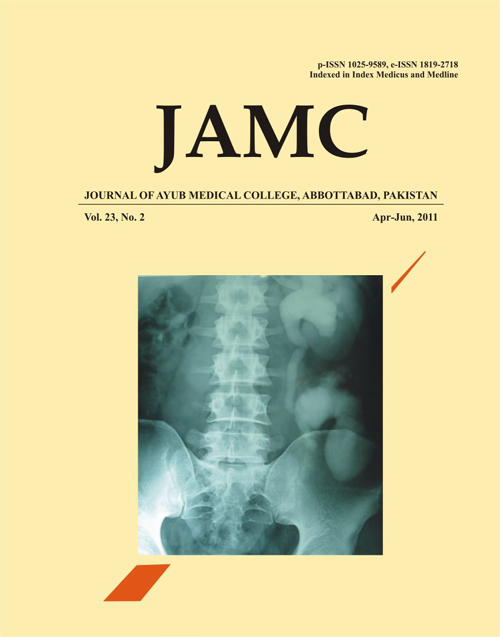HELICOBACTER PYLORI DETECTION IN CHRONIC GASTRITIS: A COMPARISON OF STAINING METHODS
Abstract
Background: Helicobacter pylori is an important cause of chronic gastritis, gastric ulceration andgastric malignancies as gastric carcinoma and MALT lymphoma. Its definitive diagnosis is based
on histopathology. Routine H & E stain is not very effective in its detection, immune-stains and
fluorescent stains are costly. Need for simple cheap and sensitive stain has always been a topic of
hot debate and extensive research. Method: paraffin embedded blocks of all adult patients
diagnosed as chronic gastritis/gastric ulceration with no accompanying gastric pathology as
hypertrophic gastropathys, and neoplasias were taken into study. Three sections of 4 micron were
cut and stained with routine H & E, Giemsa, and Cresyl fast violet. Results: Total number of
patients was 50. Out of these 37 (74%) were males and 13 (26%) were females. Mean age of the
patients was 50.4 years. Thirty-four percent (34%) were positive in normal H & E stain, 68% were
positive in Giemsa and 76% were positive in Cresyl fast violet. Conclusion: Cresyl fast violet is a
good stain for diagnosis of H. pylori gastritis.
Keywords: H pylori, chronic gastritis, H pylori staining methods
References
Ghazzawi IM, Obidat NA. The role of Helicobacter pylori
infection in the pathogenesis of chronic urticaria. Pakistan J Med
Sci 2004;20:101-4.
Valla JD. Peptic ulcer disease and related disorders. In: Abrantine
E, Adamson JW, Kokko LA, Al-lozi MT, Aminoff MJ, (Eds).
Harrison's Principals of internal medicine. 15th ed. Vol. 1. USA:
McGraw Hill;2001.p. 1653-4.
Khokar N, Gill ML, Gastrointestinal injury from non steroidal
anti-inflammatory drugs. Rawal Med J 2003;28(2):22-4.
Anderson J, Anderson JV, Baker LRI, Benjamin N, Black GM,
Borroughs AK, et al. Gastrointestinal disease. In: Kumar and
Clark Clinical medicine: 5th ed. Philadelphia: WB Saunders;
p. 272.
MInhas KZ, Goraya F, Javid S, Shakoor A, Rizwan A, Hashmi
MT. Endoscopic and Histopathological evaluation of 306
Dyspepsic patients. Pak J Gastroentrol 2003;17:4-7.
Farooki JI, Farooki RJ. Non steroidal anti-inflammatory drugs
induced gastrotoxicity. J Coll Physicians Surg Pak 2001;11:650-5.
Jhala NC, Siegal GP Klemm K, Atkinson BF, Jhala DN.
Infiltration of Helicobacter pylori in the gastric mucosa. Am J
Clin Pathol 2003;119:101-7.
Grahm EJ, Peek MR, Krishna U, Cover LT. Global Analysis Of
helicobacter pylori gene expression in human gastric mucosa.
Gastroentrology 2002;123:1637-48.
Logan RPH, Walker MM. Epidemiology and diagnosis of
Helicobacter pylori infection BMJ 2001;323:920-2.
Westblom TU, Madan E, Kemp J. Improved visualisation of
mucous penitration by Campylobecter pylori using a BrownHopps stain. J Clin Pathol 1988;41:232.
Burnett RA, Brown IL, Findlay J. Cresyl Fast Violet Staining
Method For campylobacter like organisms. J Clin Pathol
;40:353.
Malaty HM, Graham DY. Importance of childhood
socioeconomic status on the current prevalence of Helicobacter
pylori infection. Gut 1994;35:742-5.
Suerbaum S, Michetti P. Helicobacter pylori infection. N Engl J
Med 2002;347:1175-86.
Razumovic JJ, Tentor D, Kusec V, Cuzic S, Brkic T.
Histopathological features of Gastritis before and after treatment
for helicobacter pylori. Croat Med J 2000;41:159-62.
Cotran RS, Kumar V, Collins T. The gastro intestinal tract. In:
Robbins pathologic basis of disease. 6thed. Philadelphia: WB
Saunders;1999:793-5.
Walsh JH, Peterson WL. The Treatment of Helicobacter pylori
Infection In: the management of Peptic Ulcer Disease. N Engl J
Med 1995;333:984-91.
Mitchell HM, Hazell SL. Helicobacter pylori, gastric ulcer, and
duodenal ulcer. N Engl J Med 1996;335:1841-3.
Porth CM, Bancroft D, Broome ME, Carrol EW, Caudell KA,
Corwin E, et al. Alteration in gasterointestinal function. In:
Pathophysiology concepts of altered health stats. 5th ed.
Philadelphia: Lippincott-Raven; 1998.p.726-7.
Abbas SZ, English J, Abbas AB, Grawshaw A, Vivian G, Shaw
S, et al. Impact of helicobacter pylori eradication on dyspeptic
symptoms in a community. Pak J Med Sci 2003;19:95-100.
Rotimi O, Cairns A, Gray S, Moayyedi P, Dixon MF.
Histological identification of Helicobacter pylori: comparison of
staining methods. J Clin Pathol 2000;53:756-9.
Haqqani MT, Dixon M, Moayyedi P. Acridine orange stain in the
histological identification of Helicobacter pylori. J Clin Pathol
;54:734.
Walter LL, Budin RE, Paull G, Acridine Orange to identify
Campylobecter Pyloridis in formalin fixed paraffin embedded
gastric biopsies. Lancet 1986;1:42.
Downloads
How to Cite
Issue
Section
License
Journal of Ayub Medical College, Abbottabad is an OPEN ACCESS JOURNAL which means that all content is FREELY available without charge to all users whether registered with the journal or not. The work published by J Ayub Med Coll Abbottabad is licensed and distributed under the creative commons License CC BY ND Attribution-NoDerivs. Material printed in this journal is OPEN to access, and are FREE for use in academic and research work with proper citation. J Ayub Med Coll Abbottabad accepts only original material for publication with the understanding that except for abstracts, no part of the data has been published or will be submitted for publication elsewhere before appearing in J Ayub Med Coll Abbottabad. The Editorial Board of J Ayub Med Coll Abbottabad makes every effort to ensure the accuracy and authenticity of material printed in J Ayub Med Coll Abbottabad. However, conclusions and statements expressed are views of the authors and do not reflect the opinion/policy of J Ayub Med Coll Abbottabad or the Editorial Board.
USERS are allowed to read, download, copy, distribute, print, search, or link to the full texts of the articles, or use them for any other lawful purpose, without asking prior permission from the publisher or the author. This is in accordance with the BOAI definition of open access.
AUTHORS retain the rights of free downloading/unlimited e-print of full text and sharing/disseminating the article without any restriction, by any means including twitter, scholarly collaboration networks such as ResearchGate, Academia.eu, and social media sites such as Twitter, LinkedIn, Google Scholar and any other professional or academic networking site.










